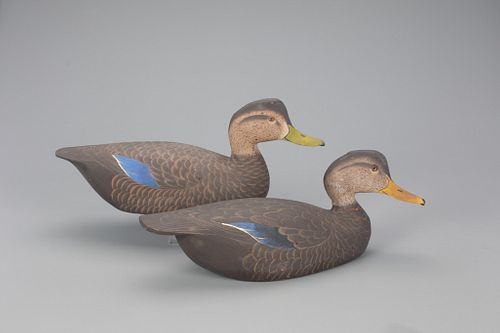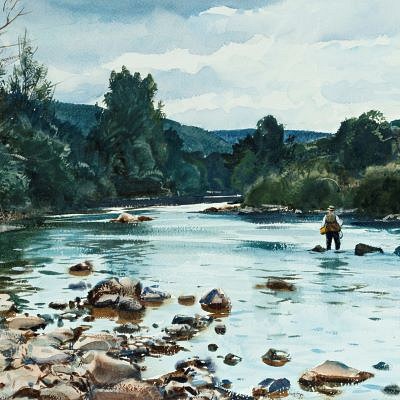The Bishops Head Black Duck Pair, The Ward Brothers
About Seller
20 Winter Street
Pembroke, MA 02359
United States
Founded in 2005, Copley Fine Art Auctions is a boutique auction house specializing in antique decoys and American, sporting, and wildlife paintings. Over the course of the last two decades, the firm has set auction records for not only individual decoy makers, but also entire carving regions. Copley...Read more
Two ways to bid:
- Leave a max absentee bid and the platform will bid on your behalf up to your maximum bid during the live auction.
- Bid live during the auction and your bids will be submitted real-time to the auctioneer.
Bid Increments
| Price | Bid Increment |
|---|---|
| $0 | $50 |
| $1,000 | $100 |
| $2,500 | $250 |
| $5,000 | $500 |
| $10,000 | $1,000 |
| $25,000 | $2,500 |
| $50,000 | $5,000 |
About Auction
Feb 20, 2021
Lots 293-596 Copley Fine Art Auctions cinnie@copleyart.com
- Lot Description
The Ward Brothers
Lemuel T. (1896-1984) and Stephen (1895-1976)
Crisfield, MD, c. 1930
The Bishops Head Fish and Gun Club was a luxury two-story lodge founded by Col. Albanus Phillips and W. Grason Winterbottom around 1923. It was a grand club which included land on a peninsula thirty miles south of Cambridge, MD, which included a man-made tidal pool. The club also included Bloodsworth Island across Hooper Strait. The lodge had a large great room with a fireplace, a locker room, and bedrooms on the second level. The caretakers had their own house, live decoy pens, and kennels. The boat dock was also used by members of the Cambridge Yacht Club, which Phillips founded as well. An avid hunter, this camp provided Phillips and Winterbottom a place of respite from their booming food-canning business. Phillips was widely known throughout the Eastern Shore and U.S. Presidents Grover Cleveland, Teddy Roosevelt, and Franklin Roosevelt were known to have been guests at his lodge. During its heyday, Bishops Head was considered one of the Eastern Shore's great hunting clubs.
The reputation of Lem and Steve Ward "spread throughout the Chesapeake region, and they produced decoys for gunners in the Upper Bay as well," reports Maryland decoy historian and author of a book on the club C. John Sullivan. He continues, "A few of the gunning clubs ordered Ward decoys, and in some cases a particular Ward style became associated with a specific club." The Bishops Head style is one such example. Known for their pronounced crowns, paddle tails, detailed body paint, high heads, and full cheeks, this black duck pair showcases all the traits associated with the club. While this distinctive design is most commonly found in geese, it is also seen in a small number of mallards, wigeon, and black ducks.
Of the numerous patterns designed by the Ward brothers over a fifty-plus-year career as decoy makers, Humpback, Pinch-Breast, and Bishops Head models have been the most highly sought after by the nation's top decoy and folk art collectors. Approximately a half-dozen premier Bishops Head black duck examples are known to have surfaced, with perhaps none finer than this pair's drake. Three of these going to important collections in Maryland, New Jersey, and Minnesota. Indeed, a single closely related hen with a slightly turned head set the record for a Ward black duck at auction, selling for over $97,000 in 2010. This male, with a thinner neck and head turned forty-five degrees, displays a nearly identical paint pattern. Additionally, this drake has an extended long, thin paddle tail, separating it from most other Bishops Head models.
Lem's ability to expertly apply feather paint is on full display across both birds from head to tail. While early decoy makers did not typically differentiate between the hens and drakes of this wary species, Lem communicates each sex through the color of their bills, a blended yellow for the drake and a green shade for the hen.
The drake is considered one of the finest black ducks from the Eastern Shore. Along with works by Elmer Crowell and Shang Wheeler, they stand as two of the finest black duck carvings known by any maker. Together they are one of the most important pairs of gunning black ducks known.
Outstanding original paint with minimal wear.
Provenance: Private Collection, acquired from the North Shore of Massachusetts
Literature: C. John Sullivan, "Bishops Head Fish and Gun Club," Bel Air, MD, 2018, club history, gunning logs, and related decoys discussed and illustrated. C. John Sullivan, "Waterfowling on the Chesapeake, 1819-1936," Baltimore, MD, 2003. R. H. Richardson, Chesapeake Bay Decoys, Cambridge, MD, 1991, p. 167, Strausburg collection rigmate illustrated. Ronald J. Gard and Brian J. McGrath, "The Ward Brothers' Decoys: A Collector's Guide," Plano, TX, 1989, pp. 75-79, Purnell collection example illustrated. Joe Engers. Year In Review 2010, Decoy Magazine, front cover and p. 9, closely related example illustrated. Copley Fine Art Auctions, The Winter Sale 2019, Charleston, SC, February 2019, front cover and lot 169, The Bishops Head wigeon pair illustrated. Loy S. Harrell, Jr., "Decoys: North America's One Hundred Greatest," Iola, WI, 2000, pp. 160-161, Bishops Head wigeon drake illustrated.Please email condition report requests to colin@copleyart.com. Any condition statement given is a courtesy to customers, Copley will not be held responsible for any errors or omissions. The absence of a condition statement does not imply that the lot is in perfect condition.Condition
- Shipping Info
-
Copley Fine Art Auctions does not handle the shipping of any items. Shipping is the sole responsibility of the buyer. Once your payment has cleared and we have received your shipping form, items may be released for shipment. Copley Fine Art Auctions, LLC shall have no liability for any loss or damage to such items. Buyers should allow up to four weeks for shipment.
Please be aware that internet bidders may NOT not pick up their items at the sale. Items will be available for pick up by appointment or by shippers five days after the sale.
-
- Buyer's Premium



 EUR
EUR CAD
CAD AUD
AUD GBP
GBP MXN
MXN HKD
HKD CNY
CNY MYR
MYR SEK
SEK SGD
SGD CHF
CHF THB
THB






















